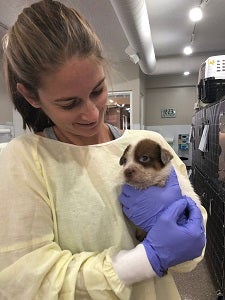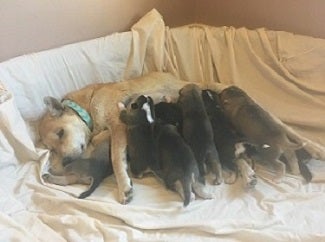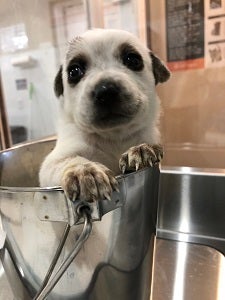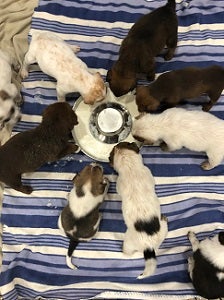Puppy Care 101
Introduction
Puppies are, of course, adorable! As their surrogate mother you will gain a whole new respect and appreciation for moms everywhere. Like human children, young puppies depend on mom for everything. The information below may seem overwhelming but after you do it once it will be a walk in the park. Congratulations on becoming a dog mom and let us jump in on how to be the best dog mom you can be!
The most important things:
Supplies you’ll need: 
If working with an animal rescue organization they might be able to provide you all of the supplies!
- Puppy specific food
- Bottles and nipples, plates and bowls
- Heat source
- Safe enclosure
- Puppy pads and/or bedding
- Baby scale
- Medical care
- Thermometer
- Toys
- Patience
Keep them full!
Puppy Specific Food – formula, rice cereal and puppy kibble
- Between zero to four weeks puppies only need formula – easy peasy!
- Around three to five weeks you can start weaning – messy but rewarding!
- Around five to six weeks pups should be eating almost independently – almost done!
- Around seven weeks pups should be full weaned – congratulations!
0-4 weeks - Neonate stage
General tips for neonates:
- Try to replicate the position pups would be in if they were nursing from mom: on their belly, head slightly up. Never ever feed a puppy on their back, this can cause the puppy to aspirate and is a life-threatening event that will require medical attention.

- When making the formula use warm water as opposed to microwaving the solution – microwaving formula denatures the proteins and decreases the nutritional value.
- Initially, you may gently squeeze the bottle just enough to fill the nipple with milk to show puppy where milk is coming from. However, do not squeeze the bottle the whole time. Puppies should suckle milk from the bottle just like they do from mom. Squeezing milk from the bottle into the puppy can cause them to get too much milk too quickly.
- After the pup is done with a bottle feeding gently massage the pup's body to release any gas build up - better known as burping! The burp may not be audible but you may feel it.
- To check the formula temperature squeeze a couple of drops onto your wrist, if you cannot feel the milk then you're good to go! The formula will cool down quickly - to help keep it warm through the duration of feeding you can use a cup of hot water and place the milk in there in between pups.
- Stimulate puppies after each feeding during this stage. Puppies should pee every feeding and poop every 24 hours. If a puppy goes more than 48 hours without pooping consult a medical professional. We will talk more about puppy poop later. Welcome to your new reality.
- Keep them clean! Puppies are cute with milk moustaches, but this is the perfect breeding ground for bacteria which can make puppies sick.
- If puppies skip one feeding during this period do not panic. However, if they are not interested in multiple feedings in a row you will need to force feed them. If a puppy goes too long without eating, their blood sugar can drop and that can be very scary for babies.
- Make sure formula and puppy is warm. Cold formula will lower body temperature and cannot be digested properly. Puppies cannot regulate their body temperature until 3 weeks old.
- The formula you use should have general directions for how much a puppy should be eating based on weight.
- Puppies should be weighed every day until four weeks old to make sure they are growing big and strong.
- Not all puppies have the same feeding style or timeline. Some puppies may need to be fed more frequently. Do not rush a puppy on to the next step. Small more frequent feedings are better.
- Satisfied puppies will spend most of their time sleeping in between feedings.
0-7 days:
- Pups should be fed every two to three hours.
- Stock up on coffee because this means night feedings as well!

7-14 days:
- Pups can be fed every three to five hours if they are thriving.
- Welcome back to sleeping more than two hours at a time!
- Eyeballs and ears open and the puppies experience the world in a new light.
14-21 days:
- Pups can be fed every four to six hours if they are thriving.
- You can almost sleep through the night!
- If eyes and ears had not opened already, they should be functional now.
21-28 days:
- Pups can be fed every five to eight hours if they are thriving.
- Hello sleeping through the night!
- Some people start weaning puppies at three weeks of age. Depending on your lifestyle and set up this may be essential to puppy’s health. Even if weaning begins now, milk must still be offered regularly as puppies would still be nursing from mom.
- Potty training can start at three weeks old (but does not have to). Stimulating puppies for elimination can be decreased to a few times a day if the pup is regularly eliminating on their own.
3-6 weeks – weaning stage
General tips for weaning:
- Transitioning can be a very odd time for a puppy as they are changing everything about the way they eat: the direction their food is coming from (down instead of above them), the texture, the taste, the smell – lots of novelties!
- Some people begin weaning around three weeks, others wait until five weeks. The decision can be made based on how interested puppy is in alternative food, how well they are gaining weight and the caregiver’s time schedule. If we are being real, not all of us have an infinite amount of time to bottle feed for weeks on end. Try your best to match the puppy’s needs with your own.
- Just like the previous stage, puppies all wean at their own pace – be patient, you are almost there! If a puppy is struggling to wean, do not fret! Continue to offer regular bottle feedings. Some puppies skip weaning and go right to kibble.
- Do not leave the food mush out for an extended amount of time. Pick up any uneaten food after 15-20 minutes to prevent attracting bacteria. Plus, it will prevent some of the mess.

- Begin offering water. Use shallow bowls to prevent pups from crawling in and/or drowning.
- At three weeks puppies can regulate their body temperature –yay! Continue to keep formula and food warm as this can be more appealing to weaning babies.
- Puppies should begin to eliminate on their own by three weeks old. Once you notice that a puppy can go to the bathroom on their own you can decrease stimulation to every other feeding or a few times a day. It is important to still check to make sure that the puppy is completely emptying their bladder and bowels.
- Puppy pads are super handy now (or use newspaper if you still get the newspaper!) and you may be surprised how quickly some puppies start utilizing a certain corner for elimination. You may also be surprised how many do not.
- Now is a great time to upgrade to a bigger puppy area.
- As puppies start eliminating on their own it is even more crucial to keep the puppies and their enclosure clean. You will quickly come to realize that this is the messiest stage for puppies. It is short lived, and you can do it!
- Puppies tend to eat with their whole bodies: feet in the bowl, belly dragging through the mush – you get the idea. Make sure you are cleaning puppies thoroughly. Even though they can regulate their body temperatures, make sure you are offering a heat source after getting cleaned up. Remember mom would be constantly cleaning them and keeping them warm.
- With new food comes new poop. Expect some surprises.
- Vaccinating and deworming can begin at four weeks and occur every two weeks until 12 weeks.
- Socializing puppies can begin during these stages. However, although more mobile, puppies still spend lots of time sleeping and it is important to let them do so.
3-4 weeks:

- Feed four to five small meals a day. You will quickly learn how much food to offer per puppy based on how much leftover mush there is.
- For weaning puppies, we use Gerber rice cereal and Esbilac formula. The rice cereal offers a good transition from just suckling milk to the concept of chewing solids.
- One cup Esbilac powder, one cup rice cereal in two cups warm water.
- Shallow bowls/plates work best as they reduce spilling/tipping of bowls and easy access for tiny puppy legs and offer room for multiple mouths.
- If puppies are reluctant to eat from dishware you can try it on the puppy pads or newspaper.
- We usually suggest three to four puppies per plate depending on size of plate and puppy. There is usually one naughty puppy who likes to push others out of her way. Pups like this may outgrow out this behavior. For now, just offer him/her their own bowl.
- If you do not have rice cereal, you can use softened kibble. Just pour a bunch of kibble in a bowl and add warm water. You can make a large batch of this and keep it in your fridge for 24 hours.
- You may still need to offer the bottle to any puppies hesitant to the new food.
- Weigh every day.
5-6 weeks:
- Feed three to four small meals a day. Pups will start eating more at each feeding and again you will quickly learn how much food to offer for each feeding.
- If you have not already started weaning or introduced softened kibble, now is a good time. You can just add some to the rice cereal and formula as an introduction for the puppies.
- As the puppies get used to eating rather than drinking – and as they get lots of puppy teeth - you can decrease the amount of formula and rice cereal in the mush and supplement with water or experiment with different consistencies. Remember the goal is to get them onto kibble!
- Manual stimulation should be done by five weeks.
- If puppies have been doing well, you can begin weighing every other day. However, if any one puppy is struggling, continue to weigh them every day.
7-8 weeks – independent puppy!
- Pups at this age should be able to eat mostly dry kibble – if you have stragglers do not despair.
- Food should be offered three times a day and puppies should not be allowed to free feed.
- The puppy food of your choice should have feeding directions. Some breeds have special dietary requirements, check with your vet for more information.
- Fresh water should always be available.
- Puppies can still be weighed every few days or once a week.
Force Feeding
You may need to switch to force feeding if a neonate is having difficulties latching onto the bottle. Difficulties feeding would mean a puppy skipping two-plus feedings in a row.
- Syringe feeding
- Syringe feeding can be done safely and comfortably.
- You will need to obtain syringes from the organization you are working with or a vet clinic. Get a few different sizes to figure out what works best for the puppy.
- You can find nipples that attach to the syringes or use the syringe opening itself.
- Gently place the syringe in the corner of the puppy’s mouth and slowly push the milk out. Making sure the puppy is swallowing.
- You may find that some puppies prefer this but try to get them onto the bottle as that most closely resembles mom and will make future eating easier.
- However, if a puppy needs syringe feeding to stay alive – that is fine! The rest will come with time.
- Ideally you will have a mentor who can show you the syringe feeding process.
- Tube feeding
- If a puppy is not responding to the bottle or syringe feeding, consult a medical professional to teach you how to tube feed.
- This is especially common in puppies born with cleft palates.
Keep them clean!
Bathing a puppy
- Use only specially formulated puppy shampoo or original dawn dish soap.
- DO NOT USE FLEA OR TICK SHAMPOO ON NEONATES. Even if they have fleas or ticks. Topical parasites should be removed manually.
- Make sure water is warm, not hot or cold as puppy temperatures are extremely sensitive to external stimuli.
- Do not get water in eyes or ears.
- Rinse all soap off.
- Dry thoroughly with towel.
- Place puppy in a smaller enclosure with heat source to make sure they are drying completely and staying warm.
Keep them warm!
Proper enclosure & set up
Zero to four weeks
- Puppies this age spend most of their time sleeping and do not need a lot of room to wander
- An open dog crate – just the bottom with the top taken off – works well as do large wire dog crate or kiddie pools. Make sure pups cannot get their extremities stuck in any openings.
- Giant stuffed animals can provide comfort to young orphaned puppies.

- Always offer a heat source AND space to get away from the heat source.
- If a puppy feels hot or cold to the touch you may need to intervene or reorganize your enclosure. Make sure there is enough heat for each puppy.
- The pup should be between 98-102 degrees Fahrenheit. If you have never taken a temperature rectally please ask a mentor for a lesson.
- Use thin bedding like sheets. If puppies get trapped under heavy bedding, they can get stuck underneath and suffocate.
- Baby wipes are great for cleaning up puppies after feeding or eliminating.
- Flea combs are super handy for combing out fecal matter.
Four to six weeks
- Puppies this age are on the move!
- Bathrooms can be great for litters of puppies as they are easy to clean and you can separate a special space for them to eliminate!
- A heat source is no longer necessary unless the puppies are wet from bathing
- Offer bedding so long as the puppies are not consuming it and it does not constrict mobility.
- Offer a variety of toys with different shapes, sizes and textures. Toys can help prevent the puppies from eating the bedding and chewing on inappropriately.
- Offer water in a shallow, heavy bowl to prevent puppies climbing in or spilling.
- Safely begin to introduce the puppies to new people and experiences.
- A general-purpose cleaner will do well in cleaning up any messes. However, it will not disinfect any surfaces. To do that you will want to use bleach or Rescue.
- Make sure you are following the directions and keeping the cleaners out of reach of the puppies. A crate can be a great place to stash puppies while cleaning their enclosure.
- Vaccinating and deworming can start at four weeks and should be done along the guidelines of a trusted veterinarian.
Keep them eliminating!
Urination
- Cotton balls, tissues or toilet paper, work well for stimulating puppies.
- You will want to begin with a dry material so you can tell if the puppy is peeing.
- Gently rub the genitalia of the puppy in a circular motion.
- Pee should be clear and odor free. Yellow pee or odor can indicate dehydration.
Defecating
- Cotton balls, tissues or toilet paper, work well for stimulating puppies.
- You can use wet or dry material depending on your preference and the puppy’s.
- Gently rub the anus of the puppy in a circular motion.
- Poop can be more difficult and take a bit more work to get out but with perseverance it will come out – and you will be surprisingly proud of yourself!
- If the puppy does not poop within 48 hours consult a mentor or medical professional. The puppy may be constipated. If the pup is full of poop there is no room for food.
- Puppy poop comes in all shapes, colors and sizes and says a lot about puppy health.
Medical
Common puppy vaccines:
- DA2PP – Distemper, Adenovirus-2, Parainfluenza and Parvovirus.
- Begin at four weeks.
- Every two weeks until 20 weeks in a shelter environment. This will be different in different environments.
- Annual boosters.
- Bordatella – Kennel cough
- As young as four weeks
- Then annually.
- Rabies
- Four to six months old for initial – lasts one year.
- After initial vaccine can get one good for three years.
Common puppy treatments for parasites:
- Pyrantel
- Eliminates all stages of round worms when done regularly.
- 1ml/10 pounds.
- Begin at four weeks and every two weeks until 16 weeks of age.
- Panacur
- Used to treat a variety of parasites.
- Only use for identified parasites not as routine dewormer.
- Ponazuril
- Used to treat for coccidia.
- Only used for identified infection, not as a routine dewormer.
- Droncit
- Used to treat tapeworms.
- Puppies usually need to be older to receive droncit.
- Milbeguard
- Heartworm preventative.
- Begin at eight weeks.
- No heartworm test needed under seven months old.
- Ticks:
- Remove manually until old enough for topical.
- Tweezers are great or tick twisters.
- Make sure to get the head.
- Drown tick in alcohol to kill.
- Save the tick if you live in an area where deadly tick borne diseases are common.
- Fleas:
- Flea combs are handy for combing out live fleas and dirt.
- Regular baths can keep numbers low until old enough for topical.
- Untreated ticks can cause anemia which can be deadly for babies.
Common puppy diseases:
- Distemper – consult a medical professional immediately if suspected
- Symptoms include:
- Bloody/runny diarrhea.
- Loss of appetite.
- Lethargy.
- Fever.
- Neurological distress.
- Coughing.
- High fatality rate.
- Highly contagious through respiratory and fecal droplets.
- Can live in the environment for just a few hours.
- Requires veterinarian assistance.
- Testing is done through polymerase chain reaction (PCR) testing.
- Long term damage a possibility.
- The DA2PP vaccination is crucial for prevention, but puppies are not reliably protected, even with multiple vaccinations, until they reach 18-20 weeks of age.
- Symptoms include:
- Parvo – consult a medical professional immediately if suspected
- Symptoms include:
- Bloody/runny diarrhea.
- Loss of appetite.
- Lethargy.
- Fever.
- Neurological distress.
- Fatal if untreated.
- Highly contagious through contact and fecal matter.
- Can live in the environment for years.
- Requires veterinarian assistance.
- Testing is done through a fecal SNAP test.
- The DA2PP vaccination is crucial for prevention, but puppies are not reliably protected, even with multiple vaccinations, until they reach 18-20 weeks of age.
- Symptoms include: